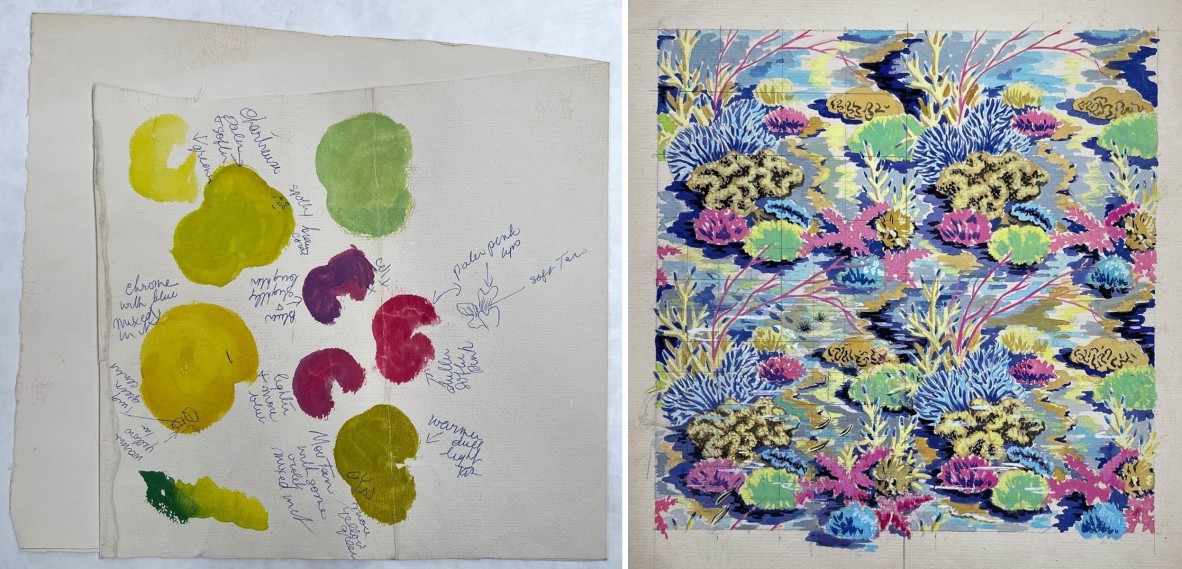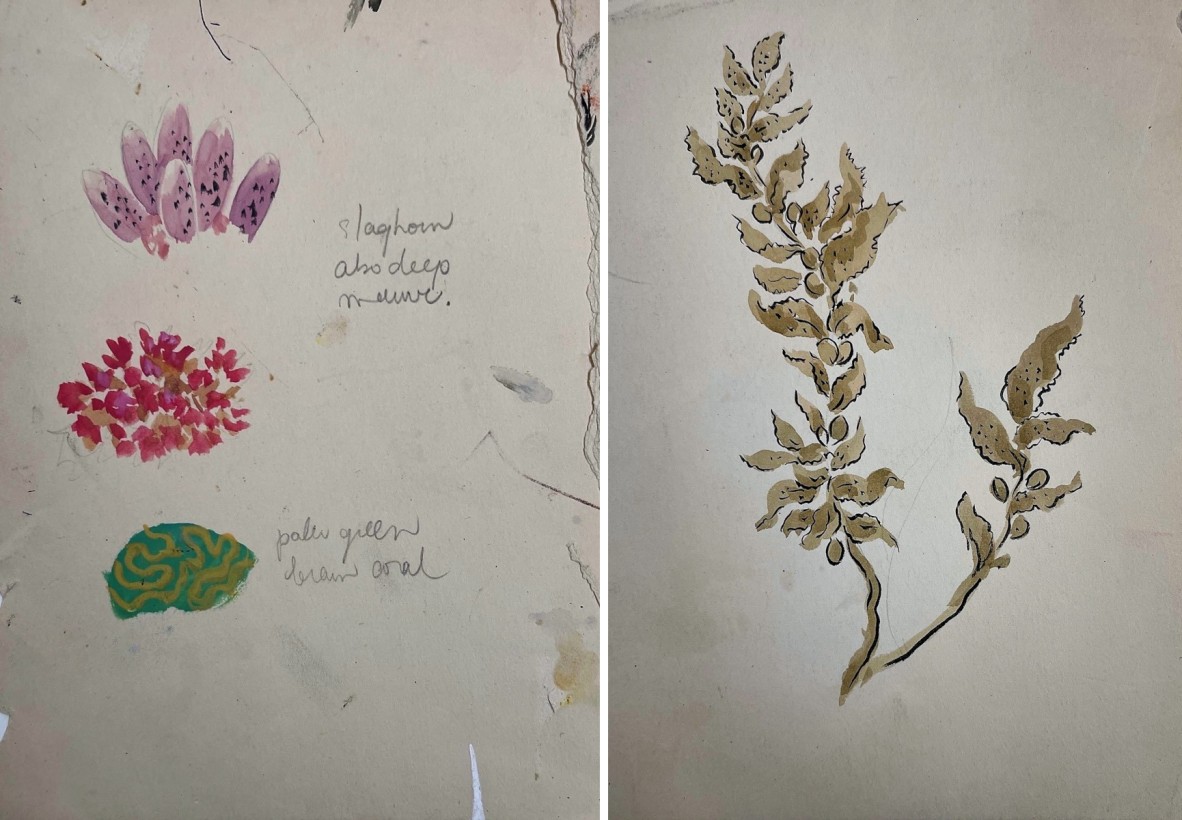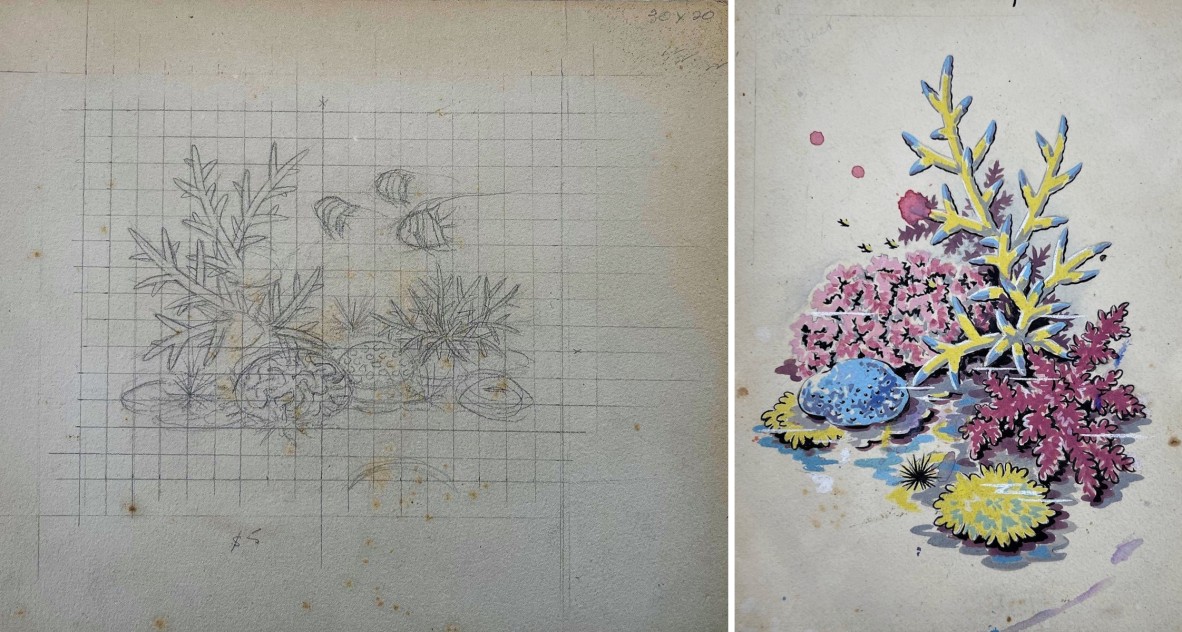Olive Ashworth: 20th century Queensland design icon
By Anna Thurgood, Engagement Officer | 29 August 2023
Olive Ashworth, visual artist, designer and businesswoman, made a significant contribution to Australia’s visual and design culture. She captured distinctive elements of the natural landscape and championed their use in her commercial and creative endeavours, developing a striking visual language that drew on her deep and abiding love for the natural environment. In so doing, Olive Ashworth helped to craft the visual identity of Queensland as a tropical paradise and a place of natural wonders.
Olive Ashworth was born in Brisbane in 1915 and educated at Somerville House where she was taught art by Enid Dickson, herself a painter and printmaker of some renown. Following the death of her father the family moved to Melbourne where Olive studied commercial art. She completed the course by correspondence when the family returned to Brisbane and soon joined the advertising department of Burns Philp & Co., a large travel and food business. She would go on to lead its art and advertising department for 12 years while also running press advertising for Penneys Stores, a chain of discount supermarkets throughout Queensland and New South Wales. During this period Olive gained valuable experience in graphic art, retail advertising and silkscreen design.
Olive travelled to the Whitsundays for a holiday on Lindeman Island in 1939, a time when tourism in the area had barely begun. Perhaps realising the potential Olive established her own freelance commercial art and advertising business, Olive Ashworth Publicity Services, in 1945. It was a well-timed move, with the emergence of a post-war tourist market coinciding with the development of island resorts in Queensland, particularly in the Whitsundays region. The nascent tourism industry in this area had developed a trend for projecting a pseudo-Hawaiian image. Olive, however, was travelling Queensland widely during this period and became deeply inspired by the beauty of local flora and fauna, including the Great Barrier Reef. From this time on, she believed strongly in featuring our own natural environments in promoting a region.

Photograph of model wearing a dress made from ‘Aquarelle’ fabric, designed by Olive Ashworth, c.1954. Photograph by Ashvin Gatha. Acc. TR1957 Olive Ashworth papers 1950s-1980s.
Olive had always been interested in textile design and in 1951 one of her designs was awarded runner-up in the Grafton Textile Design Award, sponsored by a British company. In 1954 she entered a design in the newly launched Leroy-Alcorso Award for Australian Textile Design. Ten finalists were selected and fabrics printed from their designs. Olive’s ‘Aquarelle’ design was inspired by sea grass floating above and around the reef, and the fabric proved hugely popular with customers. While Australian artist Douglas Annand won overall First Prize, Olive's design won the prize for largest amount of yardage sold. The win provided Olive with an opportunity to expand into textile design and once again, her timing was perfect, with increased international interest in the colours and motifs of the tropical Pacific.

Left: Annotated paint colour chart, undated. Right: Watercolour and gouache sketch for 'Barrier Reef Corals' design, undated. Both by Olive Ashworth. Acc. TR1957 Olive Ashworth papers 1950s-1980s. John Oxley Library, State Library of Queensland.
Commissioned by a Swedish company to produce a Great Barrier Reef furnishing fabric, Olive then designed fabrics for resorts at Heron Island in 1967 and Brampton Island and Roylen Cruises in 1970, as well as their stationery and marketing material. The following year, she established a new venture, ‘Indigenous Designs of Australia’, based on her strong belief that local imagery could be elevated into art in a striking and innovative way.
Olive began designing and producing her own furnishing and fashion fabrics, printed to her specifications and orders. She always sourced fabrics of the highest quality, usually from Japan, and resisted the temptation to produce cheaper, lower quality fabrics. A range of designs were purchased by other island resorts as ‘confined designs’ and several were sold as fashion as well as furnishing fabrics. Following the success of a cotton sarong she called a ‘Turelin’ Olive began producing resort wear and men’s casual shirts, all marketed and sold under her own label.

Left: Watercolour and gouache sketches of corals including staghorn and brain corals, undated. Right: Watercolour and ink sketch of seaweed, undated. Both by Olive Ashworth. Acc. TR1957 Olive Ashworth papers 1950s-1980s. John Oxley Library, State Library of Queensland.
Olive, who was chief artist and designer as well as director of her own companies, studied the natural environment in great detail. Many of her most striking designs were based on sketches and photographs of the reef, made from underwater observatories which were popular at the time. As a keen photographer – she used a Hasselblad camera – she made detailed studies of rainforest, flowers, corals, shells and fishes, creating reference material for her watercolour and gouache sketches that were reproduced in tourist brochures and as repeating patterns for textiles. Over time her designs, which she had often reproduced faithfully from her observations, became more stylised.
In the final decade of her career, Olive turned fully to textile design with a new business called Olive Ashworth Specialty Cottons Boutique. This late period also brought recognition for her art practice. Her textiles were purchased by the National Gallery of Australia and her work featured in exhibitions at the Queensland Art Gallery (1982), the Gold Coast City Gallery (1988) and State Library of Queensland (1991). She passed away in 2000, aged 85 years.

Left: 'Coral garden' pencil sketch on grid, undated. Right: Watercolour and gouache sketch of corals, undated. Both by Olive Ashworth. Acc. TR1957 Olive Ashworth papers 1950s-1980s. John Oxley Library, State Library of Queensland.
Olive’s descendant, Liz Watson, knew her well, reminiscing about her personality and presence as well as her contribution to Queensland and Australian visual culture:
Olive Ashworth was my grandfather’s cousin. She was present at all my early childhood events and is part of my formative memories. Olive wasn’t your usual elder citizen and family member. She was sought out for her wisdom more so than her warmth. She was fiercely independent and commanded your attention and respect.
Christmas with Olive meant sago pudding (which we all hated, but ate!) and a homemade gift, in one of her fabric prints. It was either a sun hat, a little bag for smalls or a shower cap. At the time I loved and hated the gifts in equal measure. They weren’t the fashion of the time, the colours weren’t the pinks I dreamed of.
I now look back and appreciate Olive for who she was and what she offered me as a young person. She was interested and engaged in my creative pursuits at school and later, art college and I came to respect her as someone well ahead of her time. She would pass on a book or show me her latest work in her very tidy and organised studio. She took the time to teach me about her paints and colour theory.
Her influence on me has been significant and I feel grateful that her collection is available at State Library of Queensland to browse for inspiration for my own creative pursuits and also for others to be inspired by such an incredible woman, well ahead of her time.
Highlights from Olive Ashworth's career - focused on her art and artistic process - will be on display in the Philip Bacon Heritage Gallery, on level 4 at State Library of Queensland, from late September 2023.
Explore the various State Library collections related to Olive Ashworth and her career on our online catalogue:
Comments
Your email address will not be published.
We welcome relevant, respectful comments.